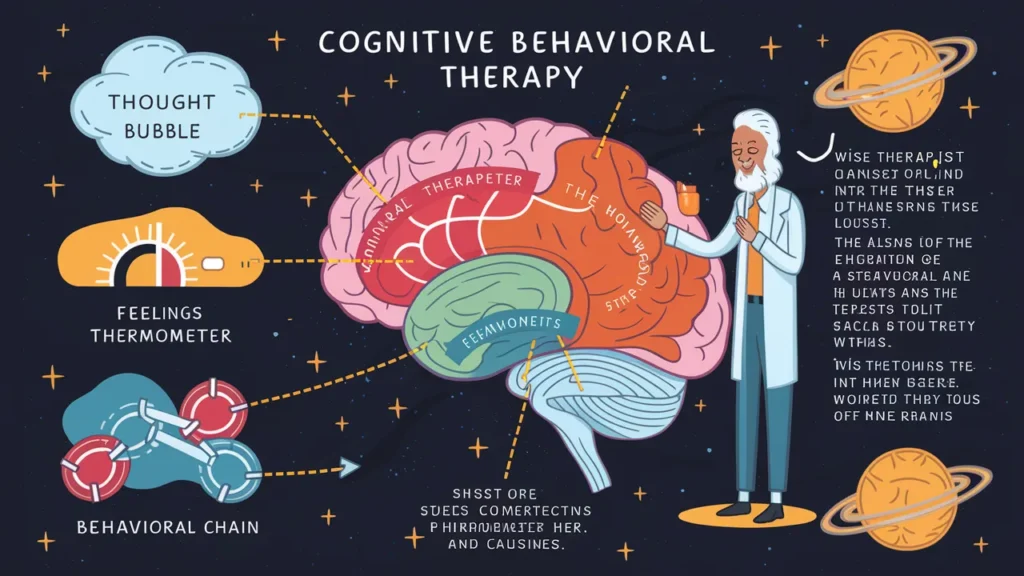Table of Contents
In the realm of mental health treatment, Cognitive Behavioral Therapy (CBT) stands as a beacon of hope and effectiveness. It has revolutionized the way therapists approach various psychological conditions, offering a structured, evidence-based approach that empowers individuals to understand and change their thoughts and behaviors. This guide delves into the core principles, techniques, and applications of CBT, shedding light on why it remains a cornerstone in modern psychotherapy.

Understanding Cognitive Behavioral Therapy
At its essence, CBT operates on the principle that our thoughts, feelings, and behaviors are interconnected. Developed initially by Dr. Aaron T. Beck in the 1960s, CBT was a breakthrough in addressing depression. Over time, it evolved into a versatile tool for treating a wide range of conditions, from anxiety disorders to substance abuse and beyond.
Core Principles of CBT
- Cognitive Restructuring: This technique involves identifying and challenging negative thought patterns that contribute to emotional distress. By replacing these thoughts with more balanced and realistic ones, individuals can alleviate their symptoms and improve their overall well-being.
- Behavioral Activation: Often used in conjunction with cognitive restructuring, this approach encourages individuals to engage in positive behaviors that counteract feelings of depression or anxiety. It helps clients regain a sense of pleasure and accomplishment in their lives.
- Exposure Therapy: Particularly effective for phobias and anxiety disorders, exposure therapy involves gradually facing feared situations or objects in a controlled and supportive environment. This process helps individuals learn that their fears are manageable and diminish over time.
Applications Across Disorders
CBT’s versatility allows it to address a myriad of psychological disorders:
- Depression: By targeting negative thought patterns and promoting behavioral activation, CBT helps individuals break the cycle of despair.
- Anxiety Disorders: Techniques like exposure therapy and relaxation training equip individuals with tools to manage and alleviate anxiety symptoms.
- Substance Use Disorders: CBT aids in identifying triggers for substance use and developing coping strategies to prevent relapse.

CBT Techniques and Tools
- Mindfulness and Relaxation Techniques: Incorporating mindfulness practices and relaxation exercises enhances CBT’s effectiveness by promoting emotional regulation and reducing stress levels.
- Homework Assignments: Between sessions, clients may be given tasks to practice skills learned in therapy, reinforcing their learning and progress.
Criticism and Controversies
Despite its widespread adoption and effectiveness, CBT is not without its critiques. Some argue that its structured approach may not fully address underlying trauma or complex psychological issues. Additionally, the effectiveness of CBT can vary depending on factors such as therapist-client rapport and the client’s readiness to engage in the process.
The Future of CBT
As research continues to refine our understanding of psychological disorders, CBT continues to evolve. Integrating new technologies and adapting to cultural and societal changes ensures that CBT remains a relevant and potent therapeutic approach in the 21st century.

Conclusion
In conclusion, Cognitive Behavioral Therapy represents a powerful tool in the mental health landscape, offering individuals the skills and insights needed to overcome debilitating psychological challenges. Its evidence-based approach, combined with a focus on collaboration between therapist and client, makes it a cornerstone of modern psychotherapy. Whether you are struggling with depression, anxiety, or simply seeking personal growth, CBT provides a structured pathway towards understanding and healing. Embrace the principles and techniques of CBT, and unlock the potential to transform your thoughts, behaviors, and ultimately, your life
